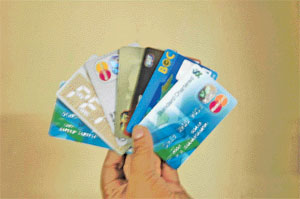|
CB issues guidelines on mobile phone based banking:
Looking to expand retail payment channel
World over, there has been a rapid growth in the use of mobile phones
in financial services and transactions. The use of the mobile phone in
facilitating financial services have brought several benefits, of which,
the foremost has been the supply of services to exclusive communities
and groups.
|

The Central bank has recognized the significance of the mobile
phone channel |
Related to financial services using mobile phones, we see two models’
namely the bank led model and non-bank led model, Central Bank Deputy
Governor, Priyantha Fernando told Daily News Business.
The bank led model involves extending banking service facilities to
bank customers through the mobile phone channel. The bank led model
incorporates the entire scope of financial services like acceptance of
deposits, money transfer facilities and extending loans. There are
applications where the outreach to very remote populations located from
far away to a bank branch is achieved by employing banking
correspondents or agents. The bank is directly responsible for the
activities of the agents, where the banks employ such agents.
In the non-bank led model, the services are supplied by a Non-bank
Service Provider (NSP). A virtual electronic pre-paid wallet on the
mobile phone broadly referred to as e-Money is provided to the customers
of this service. The customers can use the amount in the e-Money account
for remittance and for payments for goods and services, involving retail
values.
A good example of this model is M-Pesa, which is used in Kenya. This
model provides a virtual prepaid account to a customer with the NSP,
which can be used by the customer for person-to-person remittances and
payments.
In India, they first adopted the bank-led model and then the
guidelines were gradually relaxed to enable the non-bank led model to
come into operation, he said.
The Central Bank of Sri Lanka has recognized the significance of the
mobile phone channel for the development of payment instruments and to
be put into use as a retail payment channel.
Mobile payments in Sri Lanka
Accordingly, guidelines for mobile phone based banking transactions
for both bank led model and non-bank led models were issued recently.
The guideline for bank led model permits banks to provide mobile phone
banking transactions and mandates that all transactions have to
originate from one bank account and terminate in another bank account,
with the same bank or in an account of a different bank.
The guidelines also permit banks to extend the service facility
through their banking agents or banking correspondents. As per the
guideline, the service can be offered only by licensed commercial banks
to their bank customers to conduct transactions in Lanka Rupees.

In this model, the bank account number is linked to the mobile phone
number of the customer. Hence, when the customer is making a payment
transaction or a remittance, the bank account of the customer is debited
and the corresponding monetary value is credited to the recipient of
funds in the transaction involving goods and services or to the
receiving party in the case of remittance.
Deputy Governor said at present, only two banks in Sri Lanka offer
account to account transfers, the NDB through their e-z pay system and
Bank of Ceylon through the PayMate system. Other banks offer a more
basic level of service in the nature of banking information, such as
account balance enquiry, SMS alert for credit and debit transactions,
and many other information services. It is envisaged that the mobile
payments can become complemented to cash, cheques, credit cards and
debit cards providing further options for e-payment products. As per the
guidelines issued for non-bank led model (custodian bank model),
non-bank entities also have been permitted to supply mobile phone based
financial services.
Now, how does this model work?
First, the customer has to register with the NSP to use the service.
To load money into a customer’s e-Money account maintained by the
service provider, the customer has to visit an agent (usually a
boutique-keeper in the neighbourhood) and make a cash deposit, which
results in electronic money (e-Money) transferred into the customers
account.
The transfer of money is confirmed by a SMS received by both the
customer and agent. Subsequently, the customer can conveniently transfer
money to an account of other mobile service users by a SMS based
transaction. To withdraw cash from a customer’s e-Money account, the
customer need to visit the agent to make an electronic fund transfer to
the agent’s account and the agent in turn will exchange the amount
transferred for cash. This model is designed so that customers not
having bank accounts will be able to access the formal payment services.
The money deposited by each customer, until it is extinguished by
usage or withdrawal, is held safely in a bank account (custodian
account) run by the NSP on behalf of all customers. This safetynet also
ensures that the NSP cannot create new cash into the Monetary System.
Charges to the customer will be on a pay-as-you-go basis, every time a
transaction is initiated by the customer, he said.
 Despite the apparently frictionless transfer money through the air,
making a mobile phone based payment system work smoothly requires a
significant volume of backstage effort. Despite the apparently frictionless transfer money through the air,
making a mobile phone based payment system work smoothly requires a
significant volume of backstage effort.
He said considering that the technology is relatively new,
appropriate care needs to be taken on security of financial transactions
and there is a compelling need for a set of operating guidelines that
can be adopted by banks and other stakeholders. Accordingly, the
guidelines issued by the Central Bank will become very useful for
parties involved in the operational process such as; banks, mobile phone
based financial service providers, mobile phone network operators,
merchants and regulatory bodies to deliver a smooth service.
The guidelines issued recommend sound principles and risk mitigating
measures for the operation of the two models which have been described.
The guidelines address important issues, such as transparency,
disclosure, public confidence, prevention of money laundering and
countering the financing of terrorism and security features for
transaction messages in transit and transaction clearing and settlement,
Fernando said.
Sri Lanka Banks’ Association Secretary General, Upali de Silva said
several Commercial Banks have introduced Mobile Banking as part of their
on-going efforts to provide banking convenience to their customers and
also provide financial inclusion. In other words, to deliver financial
services at affordable cost to sections of low income segments of
society.
Lacking in sophistication, mobile banking has an edge over internet
banking which requires an internet connection and a computer. With
mobile banking, connectivity is not an issue, since one can find mobile
connectivity in the remotest of places. Other advantages include, mobile
banking through cell phone is user friendly, is cost effective and
Banking through mobile reduces the risk of fraud.
“We are very grateful to the Central Bank for the several initiatives
taken to regulate mobile banking in Sri Lanka,” he said.
The guidelines could be accessed by logging onto the Central Bank of
Sri Lanka website http://www.cbsl.gov.lk CdeS
|



